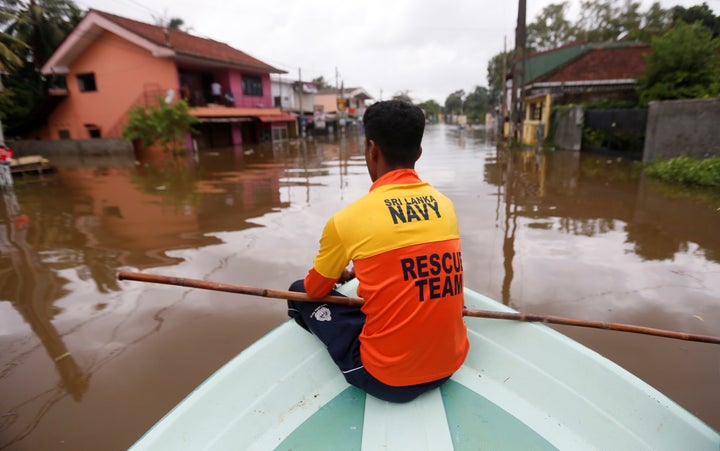
Torrential rainfall, extreme flooding and massive landslides have claimed more than 200 lives in Sri Lanka over the past few days. Property and livelihoods were destroyed or damaged, with devastating consequences for more than half a million people. Cyclone Mora formed while leaving the shores of the island.
A few days later, thousands of kilometers to the north in Bangladesh, a million people found themselves in Mora’s path. With high winds and heavy rain the cyclone destroyed hundreds of homes, particularly those of the most vulnerable. However, only a few lives have been lost as Bangladesh successfully put in place strong preparedness mechanisms.
In both countries, authorities rushed to provide emergency services, through their national networks, and often with foreign assistance. People died while trying to rescue others. Besides the lives lost and the high cost of the response, the consequences of such disasters are far-reaching. There are significant impacts on economic production, the social and mental welfare of people, the integrity of the environment and of the ecological services it provides.
These events once again highlight the need to reduce the risks typically associated with extreme weather events in densely populated areas. More than ever, it is time to ask ourselves “What has been achieved in reducing disaster related risk and building resilience, when we have events that still result in significant damage to the built environment and the associated loss of lives and livelihoods?”
UNOPS believes that the key to answering this question is to shift the focus of the Sendai Framework for Disaster Risk Reduction from “disaster” to “risk”. We must stop blaming natural events (or in many cases “climate change”), and to refocus on our own responsibilities. Are we creating the perfect conditions for a dramatic disaster to happen?
“We must consider the location and planning of urban settlements and the enforcement or lack of land use policies.”
How do we understand risk and how do we manage risks?
Risk is the probability (high or low) for a hazard to cause harm. The flooding or landslides are the hazard and the loss of life and destruction of property are the consequences. In Sri Lanka, the risk of life loss and property destruction is high in many regions where an extreme weather event may happen. This occurs because the conditions in which lives are settled, properties are built, and economic infrastructure operates are inadequate.
We can reduce or eliminate a risk. We cannot influence the rainfalls. But, we can influence how and where we build settlements, how we deforest hills, how we manage rivers.
If we are not able to alter either the hazard or the consequence then we must manage the risk.
How does the built environment impact a natural weather event, and how do we reduce the risk created through the built environment?
In 2010, Port au Prince, Haiti, was hit by a 7.8 earthquake. It claimed 250,000 lives. In 2016, an earthquake of exactly the same magnitude shook Kumamoto, Japan. It claimed 16 lives. In both cases, the hazard was very similar but the impact was dramatically different. Why? In Japan, in earthquake prone areas with human settlements, strategies and stringent building regulations were put in place. This was so that the build environment would not contribute to increase casualties and losses. Earthquake resistant building norms were applied thoroughly.
In the case of Sri Lanka and the recurring occurrence of heavy rains and cyclones, the risk is not effectively managed. Cyclones are predictable during certain seasons and they occur in a similar way each time. Yet the same consequences occur over and over again. We do not focus enough on the manmade causes.
On the east coast of Sri Lanka, over the past six years, a dozen large hotels were built on a pristine beach. No basic infrastructure was developed, particularly drainage infrastructure. Trees were cut down, and buildings were raised with disregard to national guidelines, issued after the tsunami. In 2012 and 2013, when the regular monsoon hit, the entire area was flooded. Rain water could not flow naturally. The hotels and local authorities decided build two large drainage channels. It partly solved the flooding problem, but all of a sudden, storm water was gushing into the lagoon, like a river. This severely altered salinity, and greatly damaged corrals. Subsequently, sea life suffered. So did local fishermen.
We cannot reduce or eliminate natural weather events and the hazard associated with them. But, we can impact the consequences, such as floods and landslides. We must consider the location and planning of urban settlements, and the enforcement or lack of land use policies. We must look at the existence and functioning of drainage infrastructure. We need to study the deforestation rate of hill sides, the construction of roads and other infrastructure that stop the water flow.
We cannot accept artificial trade-offs any longer (“deforesting hills is necessary to settle people or plant cash crops, it is a necessary evil for our exports, it will bring economic development”). Deforestation of hills very simply makes it very likely that during the next heavy rain, the hill will collapse and kill.
In Sri Lanka, it becomes critical that we undertake extensive failure analysis in the regions affected. We must do this beyond the needs assessments for food, water, shelter and emergency medical services. We must shift to risk informed infrastructure planning strategies, and invest resources in the implementation of those strategies. This will need to be a joint effort between the central planning institutions (ministry of planning, ministry of finance), line ministries, local authorities, communities and development partners. We must raise the quality of what we build, as well as thoroughly enforce regulations such as construction standards, land use rules, and environmental management.
Build Back Better can be more than an aspirational concept for international conferences. It can be implemented from today and put Sri Lanka on the path of sustainable development and happiness.